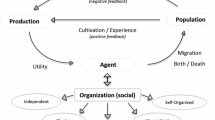Abstract
The questions about the emergence, functioning, and decline of empires in human history continue to attract scholarly attention. Conventional research has identified economics, population, climate change, and international relations as important factors that determine the constant rising and falling of empires. Based on them, we proposed a more scientific and advanced method, agent-based modeling, to investigate the life cycle dynamics. The sandpile model is applied to build multi-agent systems. According to the sandpile model, the dissipative structure and chaos theory coincides with the life cycle dynamics, which is evolving periodically. Agent-based sandpile model is applied here to investigate, simulate, and back-calculate Vietnam empires. According to this, we can find the optimal solutions, under which repeated simulations (N = 1000) can perfectly match empires in history. Macroscopically, the number of simulated empires is normally distributed. The average number of simulated empires is 9.634 (≈10), which strictly matches 10 empires in real history. Combining agent-based modeling and simulations, this work unveils the homogeneity or similarity between natural systems (sandpile) and human societies (empires).
Access this chapter
Tax calculation will be finalised at checkout
Purchases are for personal use only
Similar content being viewed by others
References
Suny, R.G.: The empire strikes out: imperial Russia, ‘national’ identity, and theories of empire. A state of nations: Empire and nation-making in the age of Lenin and Stalin, 23–66 (2001)
Taagepera, R.: Patterns of Empire Growth and Decline: Context for Russia. unpublished paper, March (1995)
Bondaletov, V., Maslikov, V.: Evolution of sociological knowledge in the field of self-organization of society. In: Economic and Social Development: Book of Proceedings, pp. 1075–1081 (2017)
Skokov, V.N., Koverda, V.P., Reshetnikov, A.V.: Self-organization of a critical state and 1/fα-fluctuations at film boiling. Phys. Lett. A 263(4–6), 430–433 (1999)
Norgaard, R.B.: Development betrayed: The end of progress and a co-evolutionary revisioning of the future. Routledge (2006)
Taylor, K.W.: A History of the Vietnamese. Cambridge University Press (2013)
Pryor, R.G., Bright, J.: The chaos theory of careers. Aust. J. Career Dev. 12(3), 12–20 (2003)
Lorenz, E.N.: Deterministic nonperiodic flow. J. Atmos. Sci. 20(2), 130–141 (1963)
Gregersen, H., Sailer, L.: Chaos theory and its implications for social science research. Hum. Rel. 46(7), 777–802 (1993)
Kiel, L.D., Elliott, E.W.: Chaos Theory in the Social Sciences: Foundations and Applications. University of Michigan Press (1996)
Usher, D.: The dynastic cycle and the stationary state. Am. Econ. Rev. 1031–1044 (1989)
Levy, D.: Chaos theory and strategy: theory, application, and managerial implications. Strateg. Manag. J. 15(S2), 167–178 (1994)
Brock, W.A., Hsieh, D.A., LeBaron, B.D., Brock, W.E.: Nonlinear Dynamics, Chaos, and Instability: Statistical Theory and Economic Evidence. MIT Press (1991)
Feichtinger, G., Forst, C.V., Piccardi, C.: A nonlinear dynamical model for the dynastic cycle. Chaos, Solitons Fractals 7(2), 257–271 (1996)
Piccardi, C.A.R.L.O., Feichtinger, G.: Peak-to-peak dynamics in the dynastic cycle. Chaos Solit. Fract. 13(2), 195–202 (2002)
Meskill, J.T.: The Pattern of Chinese History Cycles, Development, or Stagnation? (1965)
Murphy, P.: Chaos theory as a model for managing issues and crises. Public Rel. Rev. 22(2), 95–113 (1996)
Vandervert, L.R.: Chaos theory and the evolution of consciousness and mind: a thermodynamic-holographic resolution to the mind-body problem. New Ideas Psychol. 13(2), 107–127 (1995)
Ferguson, N.: Complexity and collapse: empires on the edge of chaos. Foreign Aff. 89, 18 (2010)
Liu, Q., Li, G., Kong, D., Huang, B., Wang, Y.: Climate, disasters, wars and the collapse of the Ming Dynasty. Environ. Earth Sci. 77(2), 44 (2018)
Creutz, M.: Abelian sandpiles. Comput. Phys. 5(2), 198–203 (1991)
Levine, L. (2010). What is... a sandpile. In Notices Amer. Math. Soc
Nagel, S.R.: Instabilities in a sandpile. Rev. Mod. Phys. 64(1), 321 (1992)
Ivashkevich, E.V., Ktitarev, D.V., Priezzhev, V.B.: Critical exponents for boundary avalanches in two-dimensional Abelian sandpile. J. Phys. A: Math. Gen. 27(16), L585 (1994)
Dhar, D., Manna, S.S.: Inverse avalanches in the abelian sandpile model. Phys. Rev. E 49(4), 2684 (1994)
Priezzhev, V.B., Ktitarev, D.V., Ivashkevich, E.V.: Formation of avalanches and critical exponents in an Abelian sandpile model. Phys. Rev. Lett. 76(12), 2093 (1996)
Manna, S.S., Stella, A.L.: Self-organized random walks and stochastic sandpile: from linear to branched avalanches. Physica A 316(1–4), 135–143 (2002)
Dorso, C.O., Dadamia, D.: Avalanche prediction in Abelian sandpile model. Physica A 308(1–4), 179–191 (2002)
Lee, D.S., Goh, K.I., Kahng, B., Kim, D.: Sandpile avalanche dynamics on scale-free networks. Physica A 338(1–2), 84–91 (2004)
Tarun, A.B., Paguirigan, A.A., Jr., Batac, R.C.: Spatiotemporal recurrences of sandpile avalanches. Physica A 436, 293–300 (2015)
Abar, S., Theodoropoulos, G.K., Lemarinier, P., O’Hare, G.M.: Agent based modelling and simulation tools: a review of the state-of-art software. Comput. Sci. Rev. 24, 13–33 (2017)
Grimm, V., et al.: A standard protocol for describing individual-based and agent-based models. Ecol. Model. 198(1–2), 115–126 (2006)
Grimm, V., Berger, U., DeAngelis, D.L., Polhill, J.G., Giske, J., Railsback, S.F.: The ODD protocol: a review and first update. Ecol. Model. 221(23), 2760–2768 (2010)
Grimm, V., Polhill, G., Touza, J.: Documenting social simulation models: the ODD protocol as a standard. In: Edmonds, B., Meyer, R. (eds.) Simulating social complexity. UCS, pp. 349–365. Springer, Cham (2017). https://doi.org/10.1007/978-3-319-66948-9_15
Grimm, V., et al.: The ODD protocol for describing agent-based and other simulation models: A second update to improve clarity, replication, and structural realism. J. Artif. Soc. Soc. Simul. 23(2) (2020)
Lockhart, B.M.: Vietnamese (Dai Viet) Empire. The Encyclopedia of Empire, 1–6 (2016)
Juzheng, X.: Old history of the Five Dynasties. Zhonghua Book Company (in Chinese) (1976)
Author information
Authors and Affiliations
Corresponding author
Editor information
Editors and Affiliations
Rights and permissions
Copyright information
© 2024 The Author(s), under exclusive license to Springer Nature Singapore Pte Ltd.
About this paper
Cite this paper
Lu, P., Li, M., Zhang, Z. (2024). Vietnam Dynasty and Sandpile Modeling. In: Sun, Y., Lu, T., Wang, T., Fan, H., Liu, D., Du, B. (eds) Computer Supported Cooperative Work and Social Computing. ChineseCSCW 2023. Communications in Computer and Information Science, vol 2012. Springer, Singapore. https://doi.org/10.1007/978-981-99-9637-7_29
Download citation
DOI: https://doi.org/10.1007/978-981-99-9637-7_29
Published:
Publisher Name: Springer, Singapore
Print ISBN: 978-981-99-9636-0
Online ISBN: 978-981-99-9637-7
eBook Packages: Computer ScienceComputer Science (R0)





